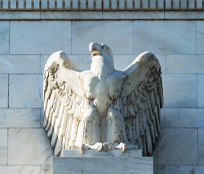In a widely anticipated move, the Federal Open Market Committee (FOMC) today reduced the target range for the fed funds rate by another 25 basis points (bps) to 4.25%-4.50%. This marks the third consecutive FOMC meeting that resulted in a cut, bringing the policy rate 100 bps below the peak level that prevailed from July 2023 to September 2024. Beyond today’s cut, it was the Federal Reserve’s (Fed) guidance for 2025 and 2026 that surprised the market and caused a substantial move higher in Treasury yields.
The newly updated Summary of Economic Projections (SEP) indicated just 50 bps of additional rate cuts in 2025 and 2026 versus the 100 bps and 50 bps, respectively, that were forecast in the September SEP. During the post-meeting press conference, virtually all of the questions directed at Fed Chair Powell attempted to ascertain why the committee would cut rates at all in 2025 given upward revisions to the Fed’s inflation and growth forecasts. In response, Powell admitted that even today’s cut was “a closer call” than prior cut decisions but that policy rates are still widely viewed as restrictive, and that further cuts are likely necessary to balance both sides of the dual mandate. Powell went on to describe the Fed’s policy as now entering a “new phase” in which higher-than-expected growth and inflation data, a lower-than-expected unemployment rate, 100 bps of already-implemented rate cuts and election-related uncertainty altogether necessitate a more gradual path toward neutral rates. He went on to emphasize the important role of incoming inflation data in determining the “extent and timing of” additional policy actions.
Despite his comments in September that strongly refuted the idea, Powell was surprisingly candid about the fact that some committee member forecasts incorporated potential impacts from the proposed policies of the incoming Trump administration. It is likely that this was at least partially responsible for upgrades to median inflation and growth forecasts. In addition to election-related uncertainty, it also remains unclear whether 1Q25 inflation data will exhibit the seasonal patterns of 2023 and 2024, where Q1 prints ended up being the highest of the year. Taking all of this into account, a pause from rate cuts in January is likely. Should the strength of the incoming growth and inflation data persist in the new year as was seen in the last half of 2024, a pause in the rate-cutting cycle could extend for some months longer.
With labor market indicators still pointing to conditions at or approaching pre-pandemic levels, we think the next move in rates is still likely to be down and, over time, that policy rates will likely be closer to 3% rather than 4%. However, some caution on the part of the Fed is warranted heading into 2025.



